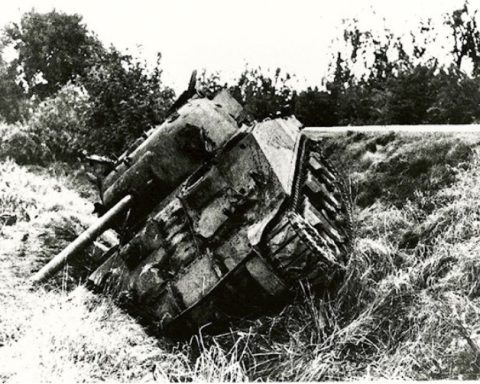The British had retreated to a defensive perimeter at Oosterbeek after failing to reach the Rhine Bridge at Arnhem. Only when it was too late did the paratroopers realize the importance of the Driel ferry near the Westerbouwing.
The sector near the Westerbouwing on the west side of the perimeter was defended by the Border regiment. Without heavy weapons and too few anti-tank guns, the troops of the Border regiment were unable to withstand a serious attack. This became apparent on Thursday, September 21.
The German attack on the western side of the British perimeter was carried out by a battalion from the Luftwaffe’s Herman Göring Non-Commissioned Officer School. The battalion was of a good standard and was supported in the attack by four Renault tanks captured by the Germans in France in 1940.
Together with the Beutepanzer, the Germans attacked the B-Company of the Border regiment. Three platoons surrounded the Westerbouwing. A fourth platoon was located slightly further back as a reserve.
The 11th platoon, which was at the front, took the full brunt of the attack. The platoon defended itself bravely and inflicted considerable losses on the German infantry. After the platoon’s only machine gun malfunctioned, it was forced to withdraw. The platoon was chased by German troops and tanks.
One of the other platoons immediately suffered a major setback when one of the first shots from the tanks destroyed the six-pound anti-tank gun. The British now only had PIAT anti-tank guns to defend themselves against the tanks.
One brave soldier managed to eliminate the threat of the Renault tanks. George Everington, the reserve platoon PIAT man, rushed from position to position firing grenades at the tanks. In one case he took cover behind a dead cow. Everington managed to destroy or disable three tanks. George Everington died a day later.
The two other platoons, No. 13 Platoon and No. 14 Platoon, held out as long as possible, but the superior numbers of the German attackers were too great. Both platoons were overrun and many British paratroopers were forced to surrender.
After a few hours of fighting, the Germans took control of the Westerbouwing. It had cost them many soldiers and three tanks, but they prevented the Driel ferry, at the bottom of the Westerbouwing, from being used by the Allies to move troops and artillery across the river.
Polish paratroopers who tried to make contact with the British at the Westerbouwing from the south bank in the evening were, to their surprise, shot at by German soldiers . That evening the Poles had wanted to use the Driel ferry to strengthen the British positions on the north side of the Rhine. Because the Germans occupied the Westerbouwing, this was now impossible.
The British survivors withdrew to a position more than half a mile behind their old position. The British had had to give up a lot of ground. However, the defensive line that the British now formed was to the advantage of the defenders. The Germans made no further attempts to advance here in the days that followed.









